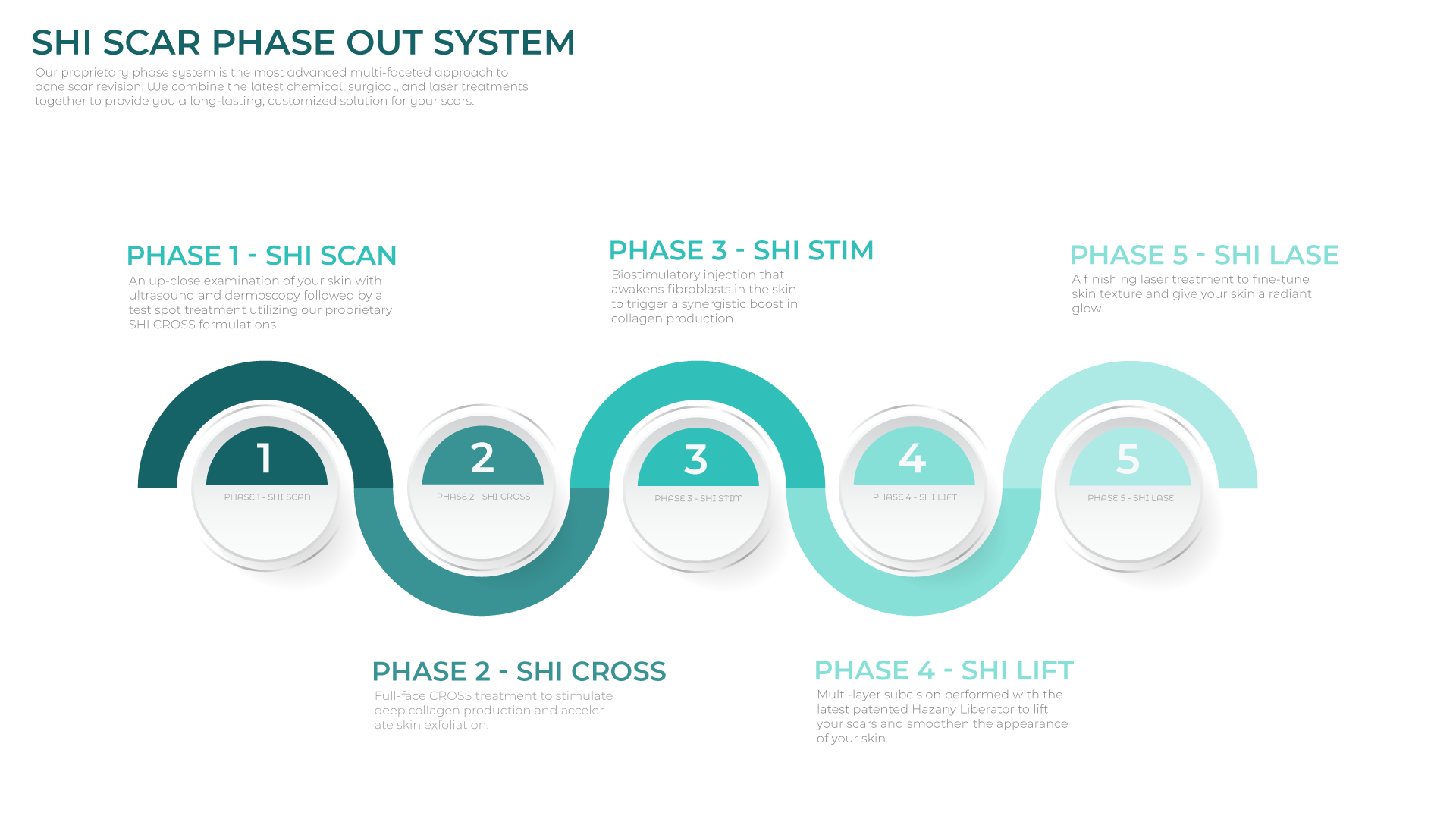If you’re struggling with acne or non-acne scars and are looking for a way to restore smooth, clear skin, laser skin resurfacing in Beverly Hills and Los Angeles might be right for you. Laser treatments can effectively minimize scars by targeting scar tissue with precision light energy.
At Scar Healing Institute, we specialize in customized laser treatments tailored to your unique needs. Our team of experts uses cutting-edge technology to help you achieve smoother, clearer skin and regain the confidence you deserve.
Ready to take the next step in your skin transformation? Book a consultation with us today and find out how laser skin resurfacing in Beverly Hills and Los Angeles can help you achieve smooth, radiant skin.
Types of Lasers for Scar Removal
In the world of laser scar removal, different types of lasers serve different purposes because they differ in their wavelength. Some of the commonly used ones include:
- Fractional ablative lasers, which offer improved results with reduced recovery time compared to conventional fully ablative lasers.
- Fully ablative lasers
- Q-switched lasers, such as the Fotona Starwalker
Er:YAG Lasers (2940 nm)
Er:YAG lasers operate by targeting the water content in skin cells, leading to their vaporization and the removal of micro-layers of skin. This process creates channels that encourage the production of new cells and collagen. Their efficacy in eliminating different skin lesions while causing minimal thermal damage to the treated skin makes them a safer option for addressing acne scars.
CO2 Lasers (10600 nm)
CO2 lasers are predominantly utilized for the treatment of fine lines, wrinkles, and various pigmentary disorders. They function by causing thermal damage below the area of scarring, proving to be effective in scar removal. They have demonstrated effectiveness in facilitating re-pigmentation and addressing conditions like vitiligo and melasma by specifically targeting the affected areas.
Fractional CO2 laser therapy plays a significant role in the healing process by normalizing collagen arrangement and stimulating the synthesis of new collagen fibers, thereby expediting the post-treatment healing response.
Q-Switched Lasers
Apart from Er:YAG and CO2 lasers, other types of lasers, such as Q-switched lasers, are also used for scar removal. These lasers work by storing energy and releasing the beam all at once, eliminating the outer skin layer at a much higher energy and generating heat in the underlying tissue. This triggers collagen production, resulting in enhanced skin tone and texture.
Q-switched lasers are especially effective in addressing atrophic facial acne scars, including atrophic scars, rolling scars, and larger boxcar scars.
Other Lasers (Non-Ablative Nd:YAG & KTP Lasers)
Non-ablative lasers, such as the Nd:YAG laser and the KTP laser, represent an advanced approach in the treatment of various types of scars, including acne scars, hypertrophic scars, and keloid scars. Unlike ablative lasers that remove the top layer of the skin, non-ablative lasers work by heating the underlying skin tissue without harming the surface, stimulating collagen production and promoting the natural healing process. This process helps in improving the texture and appearance of scars by making them less visible and more blended with the surrounding skin.
The Nd:YAG laser is particularly beneficial due to its deeper penetration, which can be more effective for certain types of scars, while the KTP laser is known for its precision and ability to target superficial vascular changes, making it suitable for scars with a vascular component. Overall, non-ablative laser therapy offers a less invasive option with minimal downtime, making it an appealing choice for patients seeking to improve the appearance of their scars.
Types of Lasers for Scar Removal
In the world of laser scar removal, different types of lasers serve different purposes because they differ in their wavelength. Some of the commonly used ones include:
- Fractional ablative lasers, which offer improved results with reduced recovery time compared to conventional fully ablative lasers.
- Fully ablative lasers
- Q-switched lasers, such as the Fotona Starwalker
Er:YAG Lasers (2940 nm)
Er:YAG lasers operate by targeting the water content in skin cells, leading to their vaporization and the removal of micro-layers of skin. This process creates channels that encourage the production of new cells and collagen. Their efficacy in eliminating different skin lesions while causing minimal thermal damage to the treated skin makes them a safer option for addressing acne scars.
CO2 Lasers (10600 nm)
CO2 lasers are predominantly utilized for the treatment of fine lines, wrinkles, and various pigmentary disorders. They function by causing thermal damage below the area of scarring, proving to be effective in scar removal. They have demonstrated effectiveness in facilitating re-pigmentation and addressing conditions like vitiligo and melasma by specifically targeting the affected areas.
Fractional CO2 laser therapy plays a significant role in the healing process by normalizing collagen arrangement and stimulating the synthesis of new collagen fibers, thereby expediting the post-treatment healing response.
Q-Switched Lasers
Apart from Er:YAG and CO2 lasers, other types of lasers, such as Q-switched lasers, are also used for scar removal. These lasers work by storing energy and releasing the beam all at once, eliminating the outer skin layer at a much higher energy and generating heat in the underlying tissue. This triggers collagen production, resulting in enhanced skin tone and texture.
Q-switched lasers are especially effective in addressing atrophic facial acne scars, including atrophic scars, rolling scars, and larger boxcar scars.
Other Lasers (Non-Ablative Nd:YAG & KTP Lasers)
Non-ablative lasers, such as the Nd:YAG laser and the KTP laser, represent an advanced approach in the treatment of various types of scars, including acne scars, hypertrophic scars, and keloid scars. Unlike ablative lasers that remove the top layer of the skin, non-ablative lasers work by heating the underlying skin tissue without harming the surface, stimulating collagen production and promoting the natural healing process. This process helps in improving the texture and appearance of scars by making them less visible and more blended with the surrounding skin.
The Nd:YAG laser is particularly beneficial due to its deeper penetration, which can be more effective for certain types of scars, while the KTP laser is known for its precision and ability to target superficial vascular changes, making it suitable for scars with a vascular component. Overall, non-ablative laser therapy offers a less invasive option with minimal downtime, making it an appealing choice for patients seeking to improve the appearance of their scars.
Preparing for Laser Scar Treatments
Before getting laser skin resurfacing there are several key steps you should take in preparation. The first step involves arranging a meeting with a skilled surgeon at Scar Healing Institute to address your individual requirements and examine your medical history associated with treating scars, such as its age, prior treatments, and the type of trauma or surgery that led to it.
Prior to the treatment, the following steps should be taken:
- Secure informed consent from the patient.
- Administer a topical anesthetic to the scar.
- Cleanse the treatment area using an antiseptic solution in preparation for the laser procedure.
Additionally, the pigmentation, pliability, and height of the scar should be thoroughly documented as part of the clinical assessment to aid in devising an effective treatment plan, including appropriate scar treatments.
Medical History and Consultation
Securing a medical consultation is vital as it enables a thorough assessment of your overall health, comorbidities, skin type, and scar characteristics. This ensures that the treatment is tailored effectively to your needs and can have a significant impact on the effectiveness of the scar removal.
The initial consultation for laser scar removal is expected to last approximately 30-45 minutes. Photographs are utilized during the treatment process to track the progress of scar removal and verify the attainment of desired outcomes.
Laser Treatment Options for Different Scar Types
Given the variety of scars and laser treatments, comprehending the best laser treatment options for each scar type is necessary. This section will provide a detailed look at the different scar types and the best laser treatment options for each.
Whether it’s acne scars, hypertrophic scars, keloid scars, or surgical scars, laser treatment options vary, and it’s crucial to find the one that suits your specific needs.
Acne Scars
Laser treatments, such as Er:YAG, CO2, and fractional ablative lasers, use light to blend healthy skin with acne scars, creating a more even appearance. However, at the Scar Healing Institute, we believe laser treatments are most effective as a final step after going through the Phase System, used to refine and enhance your skin’s appearance.
We often combine ablative and non-ablative lasers with other skin-rejuvenating procedures like chemical peels, microdermabrasion, and microneedling. Non-ablative lasers are less invasive with a quicker recovery, while ablative lasers require more downtime but offer deeper results.
Breast Lift Scars
Nd:YAG redness lasers can greatly improve persistent redness from breast augmentation procedures. By selectively targeting blood vessels within the scar tissue, Nd:YAG lasers reduce red or pink discoloration while alleviating pain and itchiness.
Er:YAG fractional resurfacing lasers are particularly effective for hypertrophic breast lift scars. These lasers create micro-thermal zones of injury within the scars to decrease overall volume and even out texture.
Tummy Tuck Scars
Er:YAG laser therapy is commonly recommended for tummy tuck scars due to its ability to expedite the fading of scars, with the goal of achieving a smooth and evenly toned skin appearance. It is advisable to wait for approximately a year following tummy tuck surgery before considering laser scar reduction treatments, in order to allow for adequate healing and maturation of the scars.
Hypertrophic & Keloid Scars
Pulsed-dye lasers (PDL) and Nd:YAG lasers are widely respected for their effectiveness in treating raised acne scars and other hypertrophic lesions. This is due to their ability to target blood inside the vein without impacting the surrounding tissue.
These treatments offer the benefits of reducing the red or pink color of the scar, alleviating associated pain and itchiness, and potentially flattening the raised appearance of hypertrophic scars. Er:YAG laser resurfacing or anti-inflammatory peptide injections may also be used in combination with redness laser therapy to help flatten the scar.
Finding a team that understands your skin, and your body is key.
Post-Laser Skin Resurfacing Care and Recovery
After laser skin resurfacing time can vary depending on factors like medications, treatment timing, and sun exposure. For the first few days, use a prescribed ointment (like Stratamed/Stratacel or Vaseline) and then switch to a gentle moisturizer starting on Day 5. Avoid sun exposure and harsh chemicals, and follow your provider’s instructions for the best results. Lightening creams can help with pigmentation but should only be used after scabs have fallen off.
Healing typically takes 1 to 2 weeks, with noticeable improvements in scar appearance appearing 3 to 6 months after treatment. Full results may take up to 6 months, and the effects can last 3 to 5 years, though some patients may need a touch-up. Always protect your skin from the sun to prevent further damage and scarring.
Take the next step toward revitalizing your skin—schedule a consultation today and discover how we can help you achieve the smooth, radiant complexion you deserve.
Our Proprietary Acne Scar Treatments
Meet The Acne Scar Phase-Out System
Our proprietary phase system is specifically designed to attack acne scars from all angles: chemical reconstruction from the top-down and physical reconstruction from the bottom-up and from the side. We pride ourselves in our meticulous, personalized, and longitudinal approach to treating your scars.


Treatments & Procedures
While our proprietary phase system is highly customizable and flexible for patients, we recognize that patients may benefit from other procedures as well. Explore these treatment options below and see if they may be right for you!

